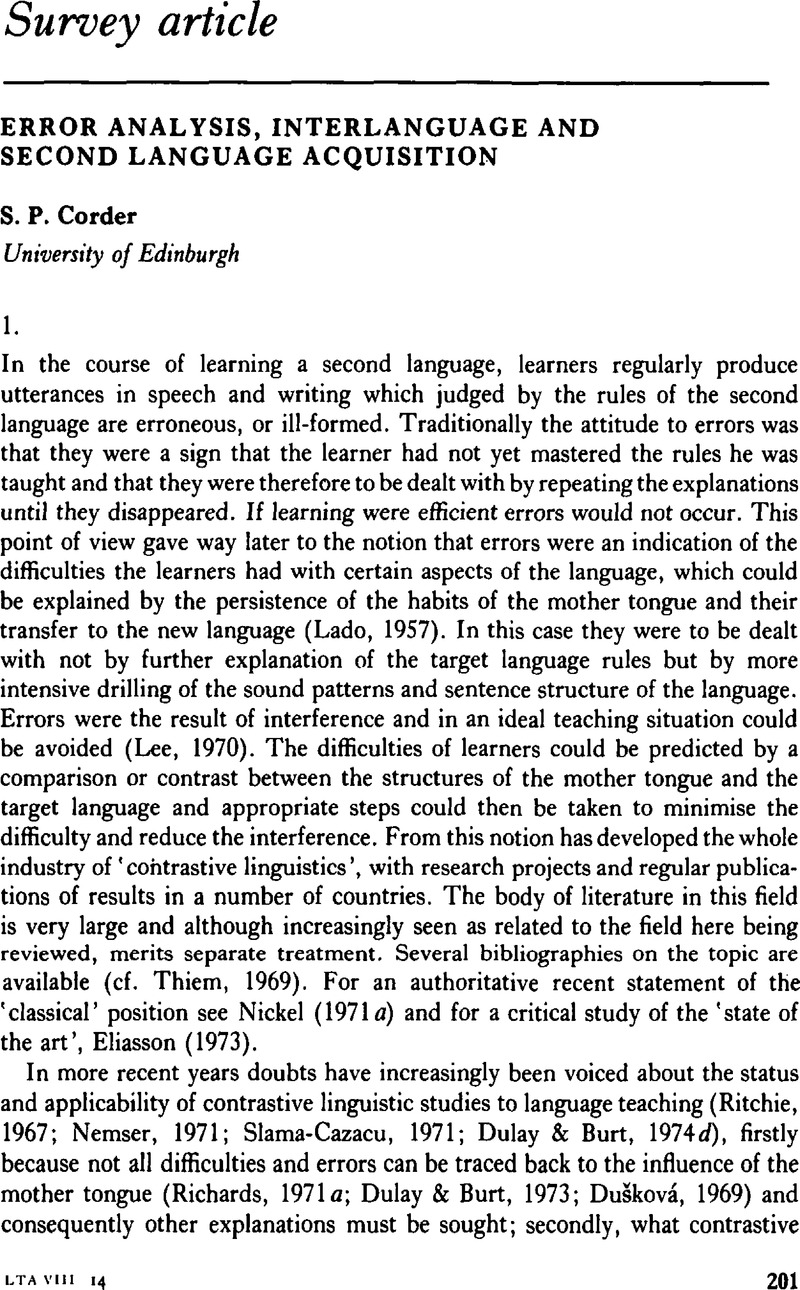Crossref Citations
This article has been cited by the following publications. This list is generated based on data provided by Crossref.
Knibbeler, W.
1980.
Fautes Dans Les Formes Verbales Françaises Faites Par Des Néerlandophones.
ITL - International Journal of Applied Linguistics,
Vol. 48,
Issue. ,
p.
59.
Richards, Jack C.
1980.
Second Language Acquisition: Error Analysis.
Annual Review of Applied Linguistics,
Vol. 1,
Issue. ,
p.
91.
Kasper, Gabriele
1982.
Teaching-induced aspects of interlanguage discourse.
Studies in Second Language Acquisition,
Vol. 4,
Issue. 2,
p.
99.
Roberts, J. T.
1982.
Recent Developments in Elt-Part I and Bibliograhy.
Language Teaching,
Vol. 15,
Issue. 2,
p.
94.
Foley, Joseph A.
1983.
More Questions on Assumptions about Cloze Testing.
RELC Journal,
Vol. 14,
Issue. 1,
p.
57.
Haynes, Lilith M.
1990.
Language Proficiency.
p.
79.
Díez-Bedmar, María Belén
2015.
Learner Corpora in Language Testing and Assessment.
Vol. 70,
Issue. ,
p.
163.
Anwar Siddiqui, Malika
2015.
Evaluating Capitalization Errors in Saudi Female Students' EFL Writing at Bisha University.
SSRN Electronic Journal,
Pennington, Martha C.
2015.
Investigating English Pronunciation.
p.
149.
Elejalde Gómez, Jessica
and
Ferreira Cabrera, Anita
2016.
ERRORES DE TRANSFERENCIA EN COMUNIDADES DE APRENDIZAJE EN LÍNEA POR APRENDIENTES DE ESPAÑOL COMO LENGUA EXTRANJERA (ELE).
Trabalhos em Linguística Aplicada,
Vol. 55,
Issue. 3,
p.
619.
Crosthwaite, Peter
2016.
L2 English article use by L1 speakers of article-less languages.
International Journal of Learner Corpus Research,
Vol. 2,
Issue. 1,
p.
68.
RONEL O. Laranjo
and
Seong-Chul Shin
2016.
Patterns of Errors in Compositions of Korean Learners of Filipino Language.
The Southeast Asian Review,
Vol. 26,
Issue. 4,
p.
365.
Cabrera, Anita Ferreira
and
Gómez, Jéssica Elejalde
2017.
Análisis de errores recurrentes en el Corpus de Aprendices de Español como Lengua Extranjera, CAELE.
Revista Brasileira de Linguística Aplicada,
Vol. 17,
Issue. 3,
p.
509.
Seung-Mi Cheon
2018.
An analysis of errors on prepositions based on online university students’ spoken learner corpus.
Studies in Foreign Language Education,
Vol. 32,
Issue. 3,
p.
229.
Hamed, Muftah
2018.
Common Linguistic Errors Among Non-English Major Libyan Students Writing.
SSRN Electronic Journal,
Peltier, Corey
and
Peltier, Tiffany K.
2020.
Mining Instruction From Student Mistakes: Conducting an Error Analysis for Mathematical Problem Solving.
Beyond Behavior,
Vol. 29,
Issue. 3,
p.
141.
Connolly, Andrew John
2020.
Adjective-Noun Order: An Error Analysis of Colombian Learners of English.
GIST – Education and Learning Research Journal,
Vol. 20,
Issue. ,
p.
231.
Lauder, Allan F.
2020.
The Handbook of Asian Englishes.
p.
605.
Arévalo, María-José
Cantera, María Asun
García-Marina, Vanessa
and
Alves-Castro, Marian
2021.
Analysis of University STEM Students’ Mathematical, Linguistic, Rhetorical–Organizational Assignment Errors.
Education Sciences,
Vol. 11,
Issue. 4,
p.
173.
Casañ-Pitarch, Ricardo
and
Gong, Jingtao
2021.
TestingImmerseMewith Chinese students: acquisition of foreign language forms and vocabulary in Spanish.
Language Learning in Higher Education,
Vol. 11,
Issue. 1,
p.
219.



